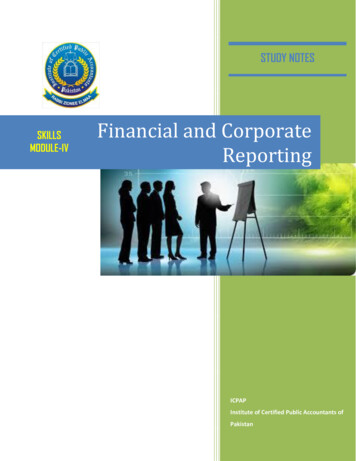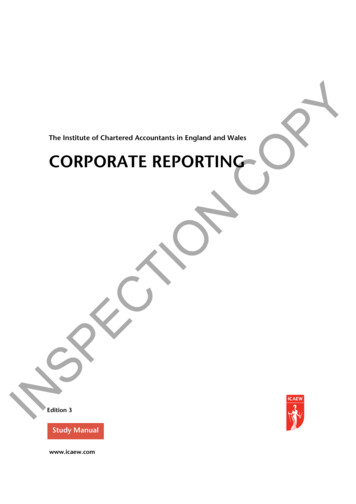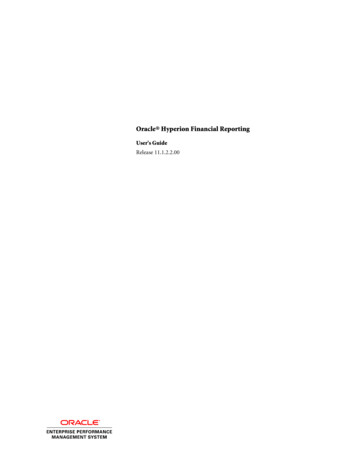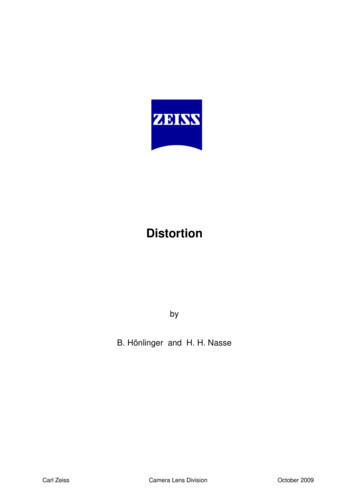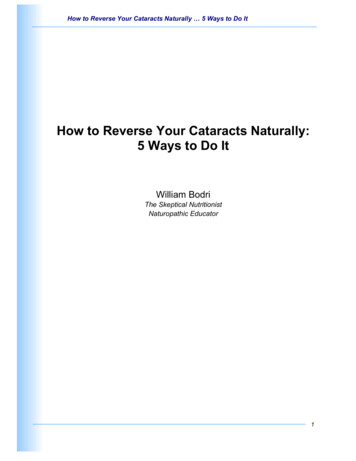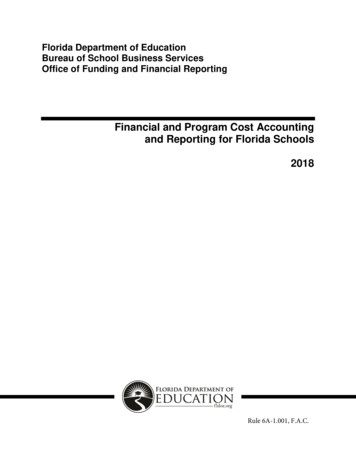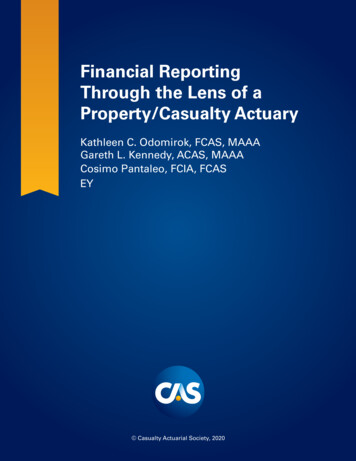
Transcription
Financial ReportingThrough the Lens of aProperty/Casualty ActuaryKathleen C. Odomirok, FCAS, MAAAGareth L. Kennedy, ACAS, MAAACosimo Pantaleo, FCIA, FCASEY Casualty Actuarial Society, 2020
FINANCIAL REPORTING THROUGH THE LENS OF A PROPERTY/CASUALTY ACTUARYForewordFOREWORDEY was originally retained by the Casualty Actuarial Society (CAS) to write a text on financialreporting and taxation as it affects reserving and statutory reporting for use in the CAS basiceducation process. The CAS had two key objectives for this text:1. Replace a number of readings that existed on the CAS Syllabus of Basic Education asof 2011 with a single educational publication.2. Refine the content of the syllabus material to focus on financial accounting andtaxation topics that are of particular relevance to the property/casualty actuary.The CAS specified that the text would focus on the learning objectives contained within thesyllabus as of 2011.This publication has been prepared from an actuary’s lens, highlighting those areas offinancial reporting and taxation deemed to be relevant by the CAS Syllabus Committee andthe authors of this text. The learning objectives contained within the 2011 syllabus providedthe underlying direction of the content contained herein. Further, the core content wasoriginally developed based on the NAIC Annual Statement Instructions in 2011.Subsequently, EY was requested to update the original textbook to:ØØØØØØØØØAdd specific examples to illustrate differences between SAP and GAAPInclude tax implications of investment strategiesReflect the new tax law enacted in the U.S. in December 2017Bring IFRS and Solvency II current (to 2018) and include discussion of the NAIC’s OwnRisk and Solvency Assessment (ORSA)Bring Schedule F current (to 2018)Provide discussion as to why companies use intercompany pooling arrangements andtheir impact on surplusReflect any resolution of discrepancies between the NAIC’s written and electronicinstructions for risk-based capital (RBC) regarding Asset Risk associated withinsurance company subsidiariesBring the Canadian chapter current (to 2018)Reflect comments and questions received by the CAS from candidates and others, aswell as errata previously submittedThis version of the text reflects the above specified changes. In doing so, we have updated theAnnual Statement for Fictitious Insurance Company to 2018. No other changes have beenincorporated, other than minor typographical edits. Further, we have not accounted for anychanges to the Exam 6 Syllabus, other than those resulting in the above requested updatesfrom the CAS. The Exam 6 learning objectives and examination material may have changed1
FINANCIAL REPORTING THROUGH THE LENS OF A PROPERTY/CASUALTY ACTUARYForewordand may continue to change in the future. Therefore, the content of this publication mayneed to be updated in the future.This text does not represent the position of EY or the authors with respect to interpretationsof accounting or tax guidance. Nor is this text intended to be a substitute for authoritativeaccounting or insurance regulatory and related guidance issued by the National Association ofInsurance Commissioners (NAIC), American Institute of Certified Public Accountants (AICPA),Financial Accounting Standards Board (FASB), Governmental Accounting Standards Board(GASB), Securities and Exchange Commission (SEC), Internal Revenue Service (IRS),Chartered Professional Accountants Canada (CPA Canada)1, International Federation ofAccountants (IFAC), Global Accounting Alliance (GAA), International Financial ReportingStandards Foundation (IFRS)/International Accounting Standards Board (IASB), or any otherregulatory body. Authoritative guidance from regulatory bodies trumps the writingscontained herein. Furthermore, accounting standards are continuously evolving. As a result,readers of this text should be aware that the accounting standards referenced in thispublication may have changed since the time of writing. The CAS may request that thispublication be updated to reflect such changes.While the authors of this publication have taken reasonable measures to verify references,content and calculations, it is possible that we may have inadvertently missed something. Wewould appreciate being informed of any inaccuracies so that an errata sheet(s) may be issued,and/or future editions of this publication may be corrected.This publication has been prepared for general informational purposes only, and is notintended to be relied upon as accounting, tax or other professional advice. It is not intendedto be a substitute for detailed research or the exercise of professional judgement. NeitherErnst & Young LLP nor any other member of the global Ernst & Young organization canaccept any responsibility for loss occasioned to any person acting or refraining from action asa result of any material in this publication. Please refer to your advisors for specific advice.1In October 2014, the Certified General Accountants Association of Canada (CGA-Canada) joined CharteredProfessional Accountants of Canada (CPA Canada) to complete the integration of the country’s national accountingbodies. CPA Canada was established the previous year by the Canadian Institute of Chartered Accountants (CICA)and The Society of Management Accountants of Canada (CMA Canada).2
FINANCIAL REPORTING THROUGH THE LENS OF A PROPERTY/CASUALTY ACTUARYAcknowledgementsACKNOWLEDGEMENTSThe authors of this publication would like to thank the CAS Syllabus Committee for its reviewof this publication and feedback provided. Special thanks goes to Sarah McNair-Grove, LauraCali, George Levine, Michel Trudeau, Miriam Fisk, Brandon Basken, Stephane McGee, SarahChevalier and Mei-Hsuan Chao who reviewed the various drafts. We would also like to thankWendy Germani who spent countless hours creating and editing the 2011 Annual Statementexcerpts for Fictitious Insurance Company. The amount of personal time spent by theseindividuals demonstrates their tremendous dedication to the actuarial profession.The authors would also like to acknowledge those individuals within EY who assisted us bycreating certain content, tables and exhibits and performing editorial reviews. Theseindividuals include Dave Osborn, Kishen Patel, and Yan Ren. Particular credit goes to DavidPayne, who rewrote Chapter 19. Risk-Based Capital, Ian Sterling and Mike McComis, whocontributed to Part VI. Differences from Statutory to other Financial/Regulatory ReportingFrameworks in the U.S., and Liam McFarlane and Shams Munir, who contributed to Part VII.Canadian-Specific Reporting.Finally, the authors of this text would like to express their deep gratitude to the actuarialprofessionals who have invested their time writing publications for the CAS examinationprocess. Although this publication will serve as a consolidation of many of the papers formerlyon the Exam 6 Syllabus, we acknowledge the significant contributions that those papers havemade in advancing the actuarial profession, as well as the knowledge of the authors of thetext.In preparing Financial Reporting through the Lens of a Property/Casualty Actuary, we reliedextensively on the following publications and resources:PUBLICATIONS2018 Insurance Expense Exhibit.American Academy of Actuaries Committee on Property and Liability Financial Reporting,Statements of Actuarial Opinion on P&C Loss Reserves, Washington, DC: American Academyof Actuaries, December 2018.Blanchard, Ralph S., “Basic Reinsurance Accounting — Selected Topics,” CAS Exam StudyNote, Arlington, VA: Casualty Actuarial Society, October 2010,http://www.casact.org/library/studynotes/6US Blanchard Oct2010.pdf.Canadian Institute of Actuaries, “Educational Note: Premium Liabilities”, 76e.pdf.3
FINANCIAL REPORTING THROUGH THE LENS OF A PROPERTY/CASUALTY ACTUARYAcknowledgementsCantin, Claudette, and Phillippe Trahan. “Study Note on the Actuarial Evaluation of PremiumLiabilities,” Journal of Actuarial Practice, 1999: 7, pp. 5- 7can.pdf.Feldblum, Sholom. “Completing and Using Schedule P,” CAS Exam Study Note, Arlington, VA:Casualty Actuarial Society, 2003, 8th eldblum7usP.pdf.Feldblum, Sholom. “Reinsurance Accounting: Schedule F,” CAS Exam Study Note, Arlington,VA: Casualty Actuarial Society, 2003, 8th eldblum7usF.pdf.Feldblum, Sholom. “Computing Taxable Income for Property-Casualty Insurance Companies,”CAS Exam Study Note, Arlington, VA: Casualty Actuarial Society, 2007, pp. 1-13,http://www.casact.org/library/studynotes/7U Feldblum2007.pdf.Feldblum, Sholom. “Federal Income Taxes and Investment Strategy,” CAS Exam Study Note,Arlington, VA: Casualty Actuarial Society, 2007, pp. 1-12,http://www.casact.org/library/studynotes/7U Feldblum Tax2007.pdf.Feldblum, Sholom, “The Insurance Expense Exhibit and the Allocation of Investment Income,”CAS Exam Study Note, Arlington, VA: Casualty Actuarial Society, May blum7can3.pdf.Feldblum, Sholom, “IRS Loss Reserve Discounting,” CAS Exam Study Note, Arlington, VA:Casualty Actuarial Society, 2007, pp. 1-13,http://www.casact.org/library/studynotes/7U Feldblum IRS 2007.pdf.Insurance Accounting and Systems Association, Property-Casualty Insurance Accounting, 8thed., 2003.MSA Research Inc., “MSA Report on Property & Casualty, Canada,” 2018.National Association of Insurance Commissioners, Accounting Practices and ProceduresManual, March 2019.National Association of Insurance Commissioners, NAIC Insurance Regulatory InformationSystem (IRIS) Ratios Manual, 2017 edition.National Association of Insurance Commissioners, Official 2011 NAIC Annual StatementBlanks, Property and Casualty, 2011.National Association of Insurance Commissioners, Official 2018 NAIC Annual StatementBlanks, Property and Casualty, 2018.4
FINANCIAL REPORTING THROUGH THE LENS OF A PROPERTY/CASUALTY ACTUARYAcknowledgementsNational Association of Insurance Commissioners, Property and Casualty Risk-Based CapitalForecasting and Instructions, 2018.Steeneck, Lee R., “Commutation of Claims," CAS Exam Study Note, Arlington, VA: CasualtyActuarial Society, 1998, pp. neck6.pdf.Troxel, Terrie T., and George E. Bouchie, Property-Liability Insurance Accounting and Finance.3rd ed. Malvern, PA: American Institute for Property and Liability Underwriters, 1990.RESOURCESActuarial Standards Board, Canada, http://www.actuaries.ca/ASB/index.cfm.Website of Office of the Superintendent of Financial Institutions, http://www.osfi-bsif.gc.ca/ MCT effective January 1, 2018 The Canadian Annual Statement Blank — P&CWebsite of Chartered Professional Accountants Canada (CPA Canada),https://www.cpacanada.ca/.Canadian Institute of Actuaries, http://www.actuaries.ca/ Dynamic Capital Adequacy Testing, Educational Note, November 2017 Draft Educational Note – Financial Condition Testing, December 20195
FINANCIAL REPORTING THROUGH THE LENS OF A PROPERTY/CASUALTY ACTUARYTable of ContentsTABLE OF CONTENTSPart I. Introduction . 8Chapter 1. Financial Reporting in the Property/Casualty Insurance Industry . 8Chapter 2. Relevance of Financial Reporting to the Actuary . 12Chapter 3. Overview of this Publication . 14Part II. Overview of Basic Accounting Concepts . 18Introduction to Part II . 18Chapter 4. Primary Financial Statements . 19Chapter 5. Key Accounting Concepts . 22Part III. SAP in the U.S.: Fundamental Aspects of the Annual Statement . 23Introduction to Part III . 23Chapter 6. Introduction to Statutory Financial Statements . 24Chapter 7. Statutory Balance Sheet: A Measure of Solvency. 25Chapter 8. The Statutory Income Statement: Income and Changes to Surplus . 41Chapter 9. Capital and Surplus Account . 57Chapter 10. Notes to Financial Statements . 62Chapter 11. General Interrogatories . 76Chapter 12. Five-Year Historical Data Exhibit . 83Chapter 13. Overview of Schedules and Their Purpose. 93Chapter 14. Schedule F . 110Chapter 15. Schedule P . 150Part IV. Statutory Filings to Accompany the Annual Statement . 200Introduction to Part IV . 200Chapter 16. Statement of Actuarial Opinion. 201Chapter 17. Actuarial Opinion Summary Supplement. 214Chapter 18. Insurance Expense Exhibit. 218Chapter 19. Risk-Based Capital. 241Chapter 20. IRIS Ratios. 3056
FINANCIAL REPORTING THROUGH THE LENS OF A PROPERTY/CASUALTY ACTUARYTable of ContentsPart V. Financial Health of Property/Casualty Insurance Companies in the U.S. . 308Introduction to Part V . 308Chapter 21. Measurement Tools . 309Part VI. Differences from Statutory to other Financial/Regulatory ReportingFrameworks in the U.S. . 319Introduction to Part VI . 319Chapter 22. U.S. GAAP, including Additional SEC Reporting. 320Chapter 23. Fair Value Under Purchase GAAP . 339Chapter 24. International Financial Reporting Standards. 345Chapter 25. Solvency II . 349Chapter 26. Taxation in the U.S. . 357Part VII. Canadian-Specific Reporting. 364Introduction to Part VII . 364Chapter 27. Overview of Financial Reporting in Canada . 365Chapter 28. Canadian Annual RETURN . 369Chapter 29. Financial Health of Property/Casualty Insurance Companies in Canada . 386Part VIII. The Future of SAP . 400Introduction to Part VIII . 400Chapter 30. The Future of Financial Reporting and Solvency Monitoring of InsuranceCompanies. 401Appendices . 427Appendix I. Fictitious Insurance CompanyExcerpts from the 2018 Annual Statement for Fictitious Insurance CompanyExcerpts from the 2018 Insurance Expense Exhibit for Fictitious Insurance Company2018 Statement of Actuarial Opinion for Fictitious Insurance Company2018 Actuarial Opinion Summary for Fictitious Insurance CompanyResults of IRIS Ratio Tests for Fictitious Insurance CompanyAppendix II. Canadian Financial Statements2018 Balance Sheet for all Property/Casualty Insurance Companies2018 Income Statement for all Property/Casualty Insurance Companies7
FINANCIAL REPORTING THROUGH THE LENS OF A PROPERTY/CASUALTY ACTUARYPart I. IntroductionPART I. INTRODUCTIONCHAPTER 1. FINANCIAL REPORTING IN THE PROPERTY/CASUALTY INSURANCEINDUSTRYIMPORTANCE AND OBJECTIVES OF FINANCIAL REPORTINGFinancial reporting serves as a means to communicate a company’s financial results andhealth. Financial reporting is accomplished through a series of financial statements thatconsolidate a company’s transactions and events into a summarized form under specifiedaccounting rules. The purpose of these rules is to provide companies with a framework formeasuring and recording transactions and the related revenue, expenses, assets andliabilities on a consistent basis.Financial reports enable stakeholders and regulators to track financial performance, comparea company’s performance to others and make informed financial decisions under a set ofcommon rules. The stakeholders of an insurance company include policyholders, claimants,investors, directors of the board and company management. The regulators primarily includestate governmental authorities, as we shall see below.OVERVIEW OF THE BASES OF FINANCIAL REPORTING (STATUTORY, GAAP, IFRS, TAX,CANADIAN) AND DIFFERENCES IN TERMS OF USEThe accounting standards that govern financial reporting for insurance companies arenumerous and complex. As we write this publication these standards are evolving, and thisevolution is resulting in much debate among industry participants. Regardless, the intent ofaccounting standards is to promote a consistent framework for reporting insurance companytransactions such that comparisons of financial performance and health of insurancecompanies can be made within the industry.In the U.S., insurance companies are regulated by the individual state governments withinwhich they are licensed to transact business. Within each state government there is aninsurance division led by an insurance commissioner, director, superintendent oradministrator (commissioner). The National Association of Insurance Commissioners (NAIC)serves as an organization of state regulators that facilitates and coordinates governanceacross the U.S. The NAIC itself is not a regulator; regulatory authority remains with theindividual states. Therefore, model laws and regulations established by the NAIC are not law;individual states have the authority to decide whether to adopt NAIC model laws andregulations.8
FINANCIAL REPORTING THROUGH THE LENS OF A PROPERTY/CASUALTY ACTUARYPart I. IntroductionStatutory Accounting Principles (SAP) is a framework of “accounting principles or practicesprescribed or permitted by an insurer’s domiciliary state.”2 Most insurance companies arelicensed to transact business in more than one state. Having to follow the accounting rulesand regulations of each state in which the company is licensed can be cumbersome and resultin inconsistent reporting practices. To minimize the varying complexities of different rulesand facilitate commonality in reporting practices, the NAIC adopted Codification of SAPeffective January 1, 2001. Codification does not prevent individual state regulation butrather provides a common set of principles that individual states can follow to ease theregulatory burden on companies and promote consistency.Statements of Statutory Accounting Principles (SSAPs) are published by the NAIC in itsAccounting Practices and Procedures Manual. The manual includes more than 100 SSAPs andreferences related statutory interpretations, NAIC model laws and actuarial guidelines whichcollectively serve as the basis for preparing and issuing statutory financial statements forinsurance companies in the U.S. in accordance with, or in the absence of, specific statutes orregulations promulgated by individual states.From a financial reporting perspective, regulatory oversight by state governments focuses oninsurance company solvency to ensure that policyholders receive the protection they areentitled to and claimants receive the applicable compensation for damages incurred. SAP andassociated monitoring tools are intended to provide regulators with early warning ofdeterioration in an insurance company’s financial condition. SAP tends to be conservative inorder to provide that early warning. For example, certain illiquid assets are not admitted(excluded from the balance sheet) under SAP, despite having economic value.Generally Accepted Accounting Principles (GAAP) provides another set of common rulesunder which publicly traded insurance companies and privately held companies report theirfinancial transactions and operating results. GAAP does have certain specialized rules forinsurance companies, but unlike SAP, this framework is not built on the principle ofconservatism. Rather, the primary focus of GAAP is the presentation of a company’s financialresults in a manner that more closely aligns with the company’s financial performance duringthe period. Historically, this has been accomplished by matching revenues and expenses. Forexample, under GAAP, expenses incurred by an insurance company in conjunction withsuccessful acquisition of business are deferred to match the earning of associated premium.In contrast, under SAP, all costs associated with policy acquisition are expensed at the timethey are incurred by the insurance company.The Securities and Exchange Commission (SEC) is the authoritative body for establishingaccounting and reporting standards for publicly traded companies in the U.S., includingpublicly traded insurance or insurance holding companies. As highlighted on the SEC’swebsite, “The mission of the U.S. Securities and Exchange Commission is to protect investors,2Preamble to the NAIC Accounting Practices and Procedures Manual, March 2019 version.9
FINANCIAL REPORTING THROUGH THE LENS OF A PROPERTY/CASUALTY ACTUARYPart I. Introductionmaintain fair, orderly and efficient markets, and facilitate capital formation.”3 The SEC hasdesignated the Financial Accounting Standards Board (FASB) with the responsibility ofdeveloping and establishing GAAP, with the SEC operating in an overall monitoring role. TheFASB is the private organization providing authoritative accounting guidance fornongovernmental entities.The Governmental Accounting Standards Board (GASB) is the private organization providingauthoritative accounting guidance for the public sector. According to the GASB’s website, theGASB “is the independent organization that establishes and improves standards of accountingand financial reporting for U.S. state and local governments . the official source of generallyaccepted accounting principles (GAAP) for state and local governments.”4 Although thispublication does not discuss accounting for governmental entities, we note that theaccounting for such entities differs from the accounting for insurance companies. Knowledgeof the GASB as it relates to insurance-related activities of governmental entities is importantfor the property/casualty actuary who performs actuarial services for the public sector.The Internal Revenue Service (IRS) is the U.S. government agency responsible for enforcingtax laws and collecting taxes. Every business paying taxes in the U.S. must compute taxableincome based on the tax laws passed by Congress and the related regulations issued by theIRS. For insurance companies, the starting point for taxable income is income determinedunder SAP. SAP income is adjusted based on the provisions of the various tax laws andregulations. While SAP is generally conservative, tax-basis accounting may be more or lessconservative depending on how political and other factors affect tax legislation. While someadjustments result in a decrease to taxable income (e.g., tax-exempt income), adjustmentsspecific to the insurance industry tend to focus on the acceleration of income for tax purposes(e.g., the discounting of loss reserves and the reduction of unearned premiums).The Canadian Institute of Chartered Accountants is the body in Canada that defines CanadianGenerally Accepted Accounting Principles (CGAAP). At one time, SAP applied to thepreparation of the Annual Return for Canadian-domiciled insurers. However, this is no longerthe case, and the financial statements included in the Annual Return are prepared inaccordance with CGAAP.Under CGAAP, policy liabilities can be recorded in accordance with accepted actuarial practicein Canada, which means that the recorded liabilities are discounted to reflect the time value ofmoney and include a provision for adverse deviation.3U.S. SEC, The Investor’s Advocate: How the SEC Protects Investors, Maintains Market Integrity, and FacilitatesCapital Formation, http://www.sec.gov/about/whatwedo.shtml, March 30, 2020.4GASB, Facts About GASB,http://www.gasb.org/cs/BlobServer?blobcol urldata&blobtable MungoBlobs&blobkey id&blobwhere 1175824006278&blobheader application%2Fpdf, 2012.10
FINANCIAL REPORTING THROUGH THE LENS OF A PROPERTY/CASUALTY ACTUARYPart I. IntroductionInternational Financial Reporting Standards (IFRS) provide an accounting framework used bymany countries outside the U.S. IFRS are established by the International AccountingStandards Board (IASB).IFRS already affects companies in the U.S. that currently have international subsidiaries orare subsidiaries of IFRS filers. At the time of the writing of this publication, IFRS 4, whichpertains to the recognition and measurement of insurance contracts, permits insurancecompanies to report under the current accounting rules of their local country with slightmodifications. An example of one such modification is requiring companies to establishpremium deficiency reserves, as needed, regardless of local requirements. Given the currentlack of a detailed measurement model under IFRS for insurance contracts, one of the keyinitiatives of the IASB is the development of a new accounting standard for insurancecontracts. We will discuss the standard developed by the IASB (and the FASB developments inthis area) and how it differs from the measurement of insurance liabilities today.11
FINANCIAL REPORTING THROUGH THE LENS OF A PROPERTY/CASUALTY ACTUARYPart I. IntroductionCHAPTER 2. RELEVANCE OF FINANCIAL REPORTING TO THE ACTUARYIMPORTANCE AND OBJECTIVES OF FINANCIAL REPORTINGActuaries estimate the financial impact of insurable events. As such, actuaries need tounderstand the accounting rules under which the financial impact is being reported. Considerthe actuary providing an estimate of an insurance company’s unpaid claims for purposes ofcomparison to recorded loss reserves on the company’s balance sheet. If the balance sheet isprepared under Statutory Accounting Principles (SAP), then the loss reserves are recorded ona net of reinsurance basis. If the company’s financial statements are prepared underGenerally Accepted Accounting Principles (GAAP), then the loss reserves are recorded grossof reinsurance. For comparison purposes, the actuarial estimate of unpaid claims would needto be prepared on a net basis for SAP and gross basis for GAAP. The actuary might alsoprovide an estimate of unpaid claims ceded to the company’s reinsurers, for comparison tothe reinsurance recoverable amount recorded as an asset on a GAAP basis.Actuaries providing estimates of unpaid claims on a SAP basis must also be aware of stateregulations under which the company is recording its loss reserves. For example, while theNational Association of Insurance Commissioners Accounting Practices and ProceduresManual permits companies to discount workers’ compensation reserves on a tabular basis,5certain states have varying requirements with respect to whether and how the tabulardiscount is applied. For instance, as of December 31, 2018, the state of Montana permitteddiscounting of both workers’ compensation indemnity and medical tabular reserves (excludingLAE) but required use of a specific interest rate in the calculation (4%).6To take this one step further, actuaries issuing Statements of Actuarial Opinion should includea statement within the opinion stating that the company’s recorded loss and loss adjustmentexpense reserves “meet the requirements of the insurance laws of (state of domicile).”7 Theopining actuary is therefore required to read the state regulations and confirm that therecorded reserves meet the state laws.The accounting convention is not only important to the reserving actuary for an insurancecompany, but also to actuaries who perform other jobs, including but not limited to thefollowing: Working with regulators to monitor the financial health of insurance companies5According to page C-3 of the American Academy of Actuaries, 2018 Property/Casualty Loss Reserve Law Manual,tabu
2. Refine the content of the syllabus material to focus on financial accounting and taxation topics that are of particular relevance to the property/casualty actuary. The CAS specified that the text would focus on the lear

